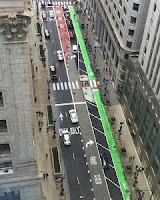I finally got to see the Washington Street segment of the Loop Link for myself. I was hugely impressed and underwhelmed at the same time. I observed a major but easily fixed flaw that I will discuss. The flaw is in this picture here, but let me say some generic stuff first.
A problem for me and I bet for many is that somewhere along the line the expectations for the CTA's Loop Link had gotten way overblown. Probably anyone using the acronym BRT contributed to overblown expectations. Since the buck stops at the CTA on this kind of issue then they get credit for the blame. They created at least one web address, BRTchicago.com, where they present the Loop Link, and it uses the letters BRT, so they can take some direct blame as well.
As has been emphasized by many, likely the CTA as well, it does a disservice to associate Loop Link with BRT. Were I the CTA I would have called it something like a Bus Priority Transitway. I would have reminded people and journalists especially that at best it is a test track for several of the features that can be found in BRT. Yes it has stations and yes it has some dedicated lane-age. But do not call it BRT.
As a test track it is great! The CTA will learn a lot from it. The whole mirror issue is just one small and minor example. The big educations will come with pre-paid boarding and signal-priority. The best way to learn is to fail. The State Street Mall provided lessons by failure for those willing to learn. There has been a lot of internet discussions of just how pre-paid boarding can fail. We can theorize all we want, but the CTA can actually try and fail and learn and even succeed with pre-payment.
Now since I know so much I will point out an actual design failure. It is one that I have heard about but not seen myself. I suggested calling it a Bus Priority Transitway for a reason. Whenever a design decision must be made the decision should prioritize buses over all other traffic when there are potential conflicts. That is the rational for the red painted dedicated for buses only lane-age. The failure I have heard about concerns the special dedicated right turn lanes for cars. These include points of shared lane-age between buses and cars so cars can cross the bus lane to get to the right turn lane.
They become a point of failure when right turning cars back up into the bus lane and prevent buses from advancing. That is what I have heard. When I observed the design I immediately realized the major short-sighted short-coming in the design: the shared lane portion. The design is a contradiction that contravenes the goal of bus priority. It grants equality for cars with regards to buses in that space rather than prioritizing buses over cars.
The contradiction becomes a major failing flaw at the very time when buses need priority most, during times of car congestion. The goal of a Bus Priority Transitway is to allow buses to continue to function when the street itself fails because of car congestion.
What should have been done? Instead of granting cars shared use, the cars should have been provided a crossover point with specific instructions to not ever block the bus lane. On the right of the picture below is an example of how it should have been designed (imho).
The design error is a result of car centric mindsets. Street designers default to optimal car design. Even when trying for optimal bus design, as seen here. Ask yourself why, when the street fails because of congestion, it is buses that must take it on the chin and not cars here. Why when the turn lane fills up are buses the vehicles that become inconvenienced rather than the cause of the congestion, the cars?
When the turn lane fills, then the excess cars should stop and back up in the right hand car lane rather than entering and filling the bus lane. Clear signage should indicate that cars are not to block the bus lane. Clear street markings should indicate where cars may cross but not stop in nor block the bus only lane. It should become habit for cars to stop and block traffic in their lane rather than blocking the bus lane.
Now it is possible that the problem is no where nearly as bad as I imagine. Maybe it only happens once or twice a day. Or even only once a week.
But hey, this is a test track, right? It is a space to try things out and fail and learn and succeed.
(By the way, isn't that a neat optical illusion? It appears that the street on the right is not parallel to the one on the left.)

